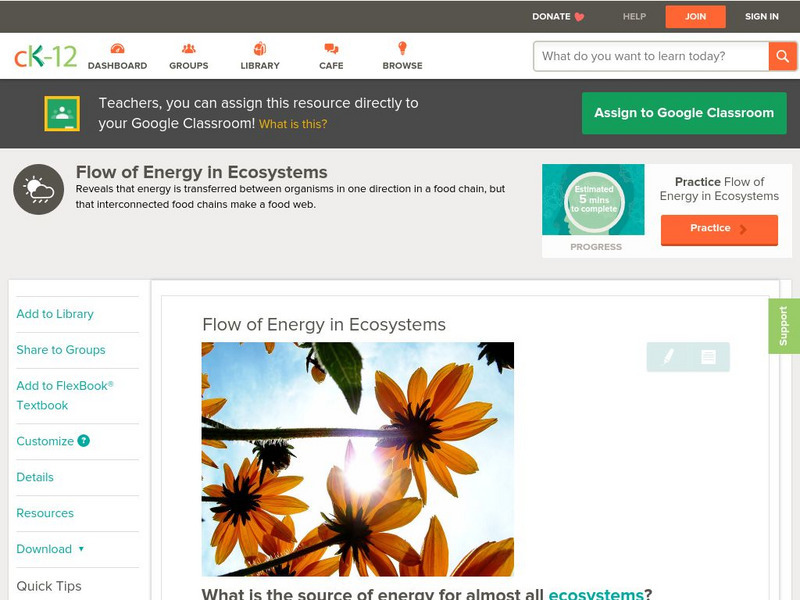CK-12 Foundation
Ck 12: Life Science: Competition
[Free Registration/Login may be required to access all resource tools.] Ecology is the study of how living organisms interact with each other and with their environment. Organisms interact with each other through various mechanisms, one...
CK-12 Foundation
Ck 12: Earth Science: Flow of Energy in Ecosystems
[Free Registration/Login may be required to access all resource tools.] Describes how energy is transferred from one organism to another.
CK-12 Foundation
Ck 12: Earth Science: Flow of Energy in Ecosystems
[Free Registration/Login may be required to access all resource tools.] Describes how energy is transferred from one organism to another.
CK-12 Foundation
Ck 12: Fifth Grade Science: Life Science: The Flow of Energy in an Ecosystem
A module that explains what an ecosystem is and how energy and matter move through them. Students will look at the different roles of plants and animals and at ecological relationships in food chains and food webs.
Concord Consortium
Concord Consortium: Evolution: Variations and Adaptations
Students discover that variation in plants allows some varieties to survive in near-drought conditions. Next, students learn that different types of rabbits prefer to eat different varieties of plants. Students make the connection...
Khan Academy
Khan Academy: Biology Foundations: Ecology Unit Test
Test your skills with this nine-question unit test.
CK-12 Foundation
Ck 12: Life Science: 12.8 Predation
Understand the predator-prey relationship in an ecosystem.
Science and Mathematics Initiative for Learning Enhancement (SMILE)
Smile: The Effects of Pesticides on the Food Chain
Lesson plan to construct and explain a food chain. Includes games and activities to teach and reinforce concepts.
Science Education Resource Center at Carleton College
Serc: Mn Step: The Flow of Energy: Balancing Ecosystems
A lesson outlining activities for a science unit where students can learn about the relationships and the flow of energy within an ecosystem. These include predator and prey, hosts and parasites, and consumers, producers, and decomposers.
BioMan Biology
Bio Man Biology: Angry Aliens: Ecology
Teach aliens about ecology as you play this game, and review your own understanding in the process. Topics covered include levels of organization, ecological relationships, nutrition and energy, cycles (water, carbon, and nitrogen), and...
Science Struck
Science Struck: Examples of Primary Consumers in the Food Chain
Explains what a primary consumer's role in a food chain is and provides examples.
Science Struck
Science Struck: Tropical Rainforest Energy Pyramid and Its Importance
Explains the roles of consumers, producers, and detrivores or decomposers and how energy flows through the different levels of the energy pyramid of a tropical rainforest.
Science Struck
Science Struck: Symbiotic Relationships in the Rainforest
Explains what mutualism, commensalism, and parasitism are.
Science Struck
Science Struck: Tropical Rainforest Food Web
Explains what a food web is, the complexity of one in a rainforest, and how energy flows through a food web.
Science Struck
Science Struck: 12 Lesser Known Examples of Intraspecific Competition
Explains what intraspecific competition is and gives examples.
Science Struck
Science Struck: Food Chain in the Tundra Region
Describes the characteristics of a tundra biome, how a tundra food chain compares to a tropical food chain, and what the different trophic levels look like.
Science Struck
Science Struck: Symbiotic Relationships in the Tundra
Explains what mutualism, commensalism, and parasitism look like in a tundra biome.
Science Struck
Science Struck: Symbiotic Relationships in the Desert
Describes three types of symbiotic relationships that can be found in a desert biome.
BiologyWise
Biology Wise: An Analogy: Biomass Pyramid vs. Energy Pyramid
Explains what biomass and energy pyramids are and provides a table highlighting their differences.
BiologyWise
Biology Wise: Examples of Beneficial Mutation
Not all genetic mutations are harmful. Examples of beneficial mutations are described here.
BiologyWise
Biology Wise: Understanding the Process of Biological Magnification
Biological magnification is the term used to described the increasing accumulation of substances in organisms as one looks at higher trophic levels in a food chain. When that substance is a toxin, such as a heavy metal or a pesticide,...
BiologyWise
Biology Wise: Facts About Autotrophs and Heterotrophs
Explains what autotrophs and heterotrophs are, the several types of each, their roles in an ecosystem's food chains, and the differences between them.









